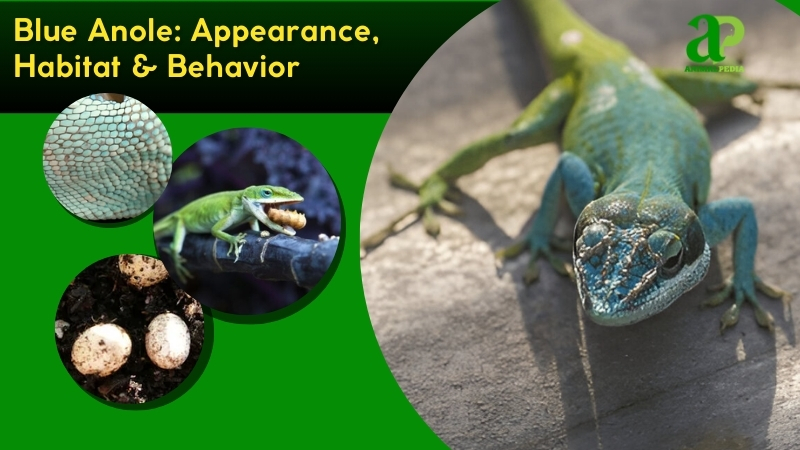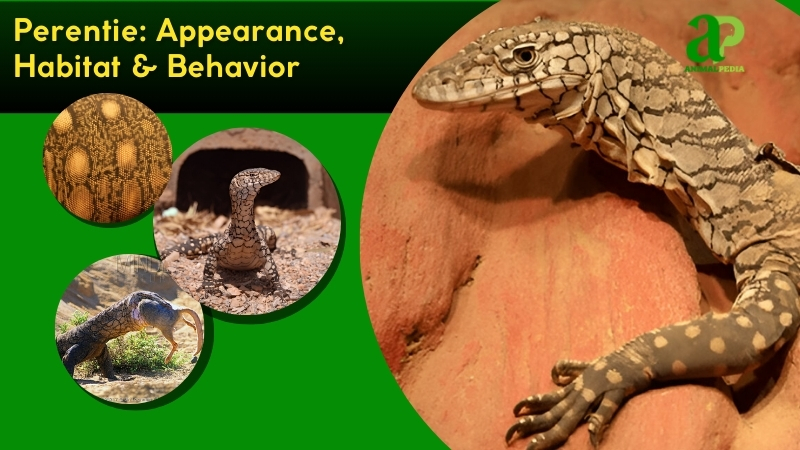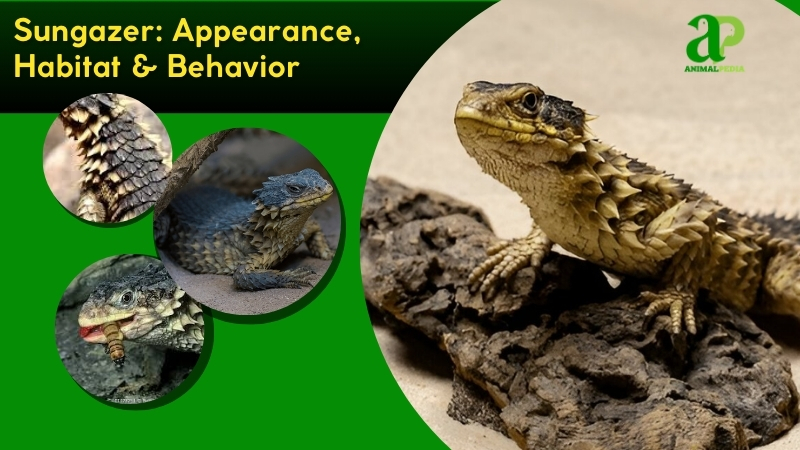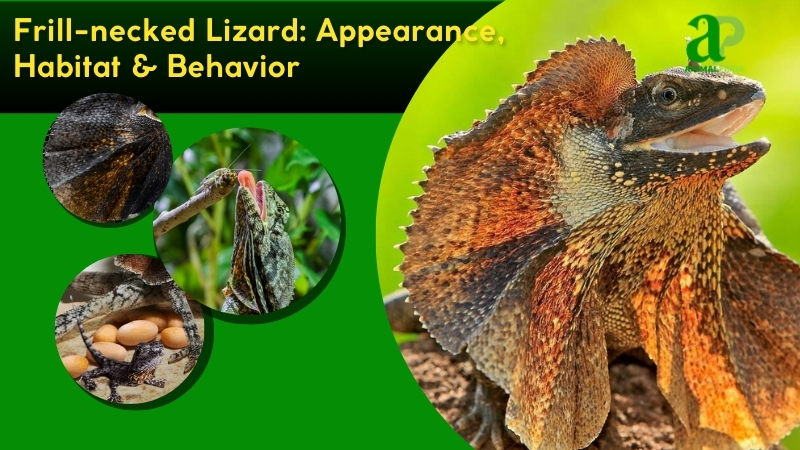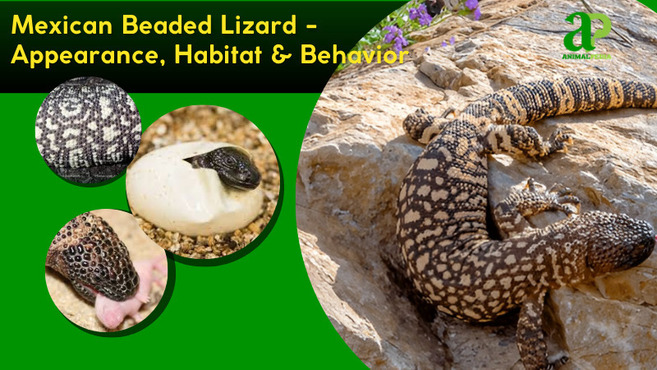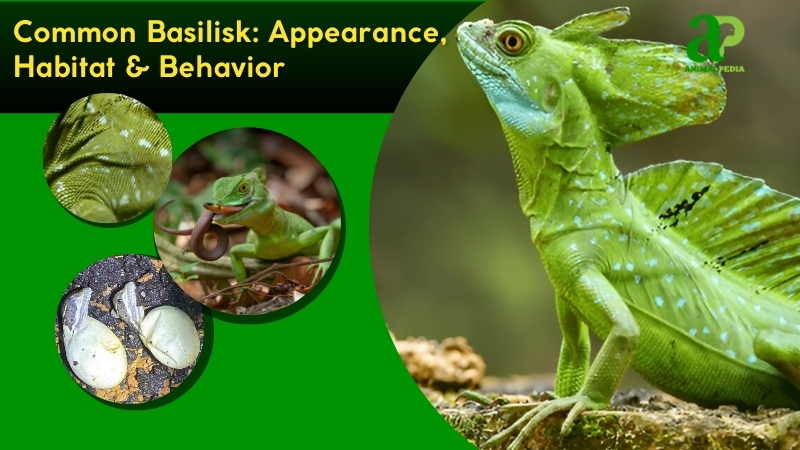The Jamaican Giant Anole, scientifically known as Anolis garmani, is a classification of reptile endemic to the lush landscapes of Jamaica. Commonly referred to as the Jamaican Giant Anole or Jamaican iguana, this impressive creature stands out with its massive size, reaching lengths of up to 18 inches, making it one of the largest anole species in the world. This size sets it apart from other anoles and contributes to its commanding presence in its habitat.
The behavior of Jamaican Giant Anoles reveals a complex social structure dominated by territorial interactions. Males establish and vigorously defend territories spanning 10-30 square meters through elaborate visual displays, including dramatic head bobbing, push-ups, and the extension of their vibrant dewlaps. These displays serve dual purposes—deterring rival males and attracting potential mates.
During breeding season, which peaks in the wet months of May to November, these behaviors intensify as males compete for prime perches that offer both visibility for mate attraction and access to insect-rich feeding grounds. Unlike many reptiles, they also employ a limited vocal repertoire, producing soft clicks and chirps that complement their visual communication strategies during territorial disputes and courtship.
Though currently classified as a species of Least Concern by conservation authorities, Jamaican Giant Anoles face increasing challenges from habitat destruction, climate change, and competition from invasive species. Their endemic status in Jamaica makes them particularly vulnerable to environmental changes that could disrupt the delicate ecological balance they help maintain.
In this article, we’ll explore the fascinating world of the Jamaican Giant Anole—examining their distinctive physical characteristics, specialized habitat requirements, and complex behaviors that have allowed them to thrive in Jamaica’s diverse ecosystems.
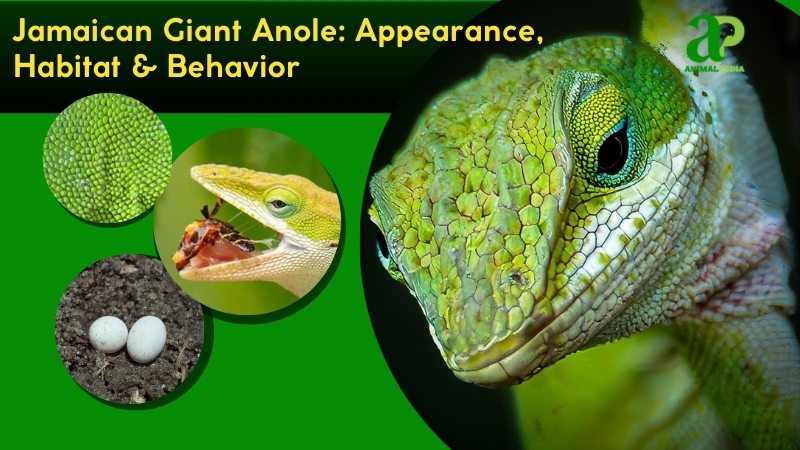
What does the Jamaican Giant Anole look like?
The Jamaican Giant Anole (Anolis garmani) has a sturdy, elongated body, measuring 7.9–11.8 inches (20–30 cm) in total length, with males reaching up to 5.2 inches (13.1 cm) snout-vent length (SVL) and females 3.7 inches (9.5 cm). Its color is a bright emerald green, shifting to dark brown or black at night, with a rough texture from keeled dorsal and lateral scales—ridged and raised for traction. Males boast a vivid yellow dewlap with an orange center, while females have a smaller, duller one. A spiny dorsal crest of pointed scales marks the back of males, not females.
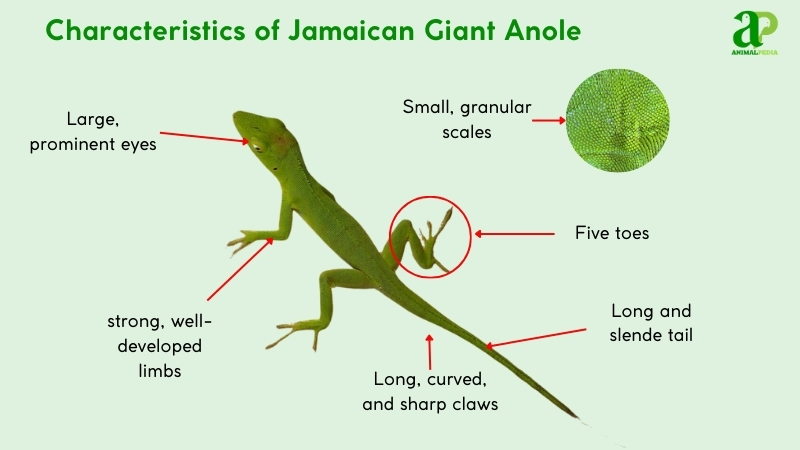
From the head, the skull fits its body size, unlike some anoles, which have larger heads. Eyes are moderately big for tree-dwelling, and the tongue snaps out fast for prey. The neck supports the male’s bold dewlap. The muscular body has strong limbs for climbing, with clawed toes featuring adhesive lamellae (toe pads) for grip. The tail, verticillate with three scales per segment, dorsally and ventrally, stretches twice the body length and ends in a violet tip in some.
How big do Jamaican Giant Anoles get?
The Jamaican Giant Anole averages 3.9–5.2 inches (10–13.1 cm) snout-vent length (SVL) for males and 3.1–3.7 inches (8–9.5 cm) for females, with weights of 0.044–0.066 lbs (20–30 g) for adults. The longest and heaviest recorded specimen stretched 14 inches (36.8 cm) in total length and weighed about 0.088 lbs (40 g), found in Jamaica, according to records on Animalia.bio and field research.
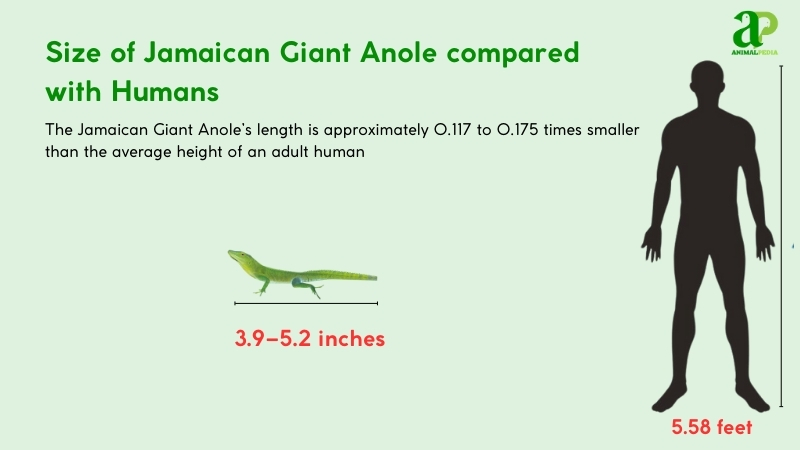
Adult Jamaican Giant Anoles reach 7.9–11.8 inches (20–30 cm) snout-to-tail. Males hit SVL of 5.2 inches (13.1 cm) and total length up to 11.8 inches (30 cm), while females reach 3.7 inches (9.5 cm) SVL and 9.8 inches (25 cm) total. Males weigh 0.055–0.088 lbs (25–40 g), females 0.033–0.055 lbs (15–25 g), highlighting dimorphism. See table:
| Gender | Length Range | Weight Range |
| Male | 7.9–11.8 in (20–30 cm) | 0.055–0.088 lbs (25–40 g) |
| Female | 7.9–9.8 in (20–25 cm) | 0.033–0.055 lbs (15–25 g) |
What are the unique physical characteristics of a Jamaican Giant Anole?
The Jamaican Giant Anole boasts a unique physical trait among anoles: a prominent dorsal crest of spiny, keeled scales running along the midline of the back in males, absent in most other species, such as the Green Anole (Anolis carolinensis).
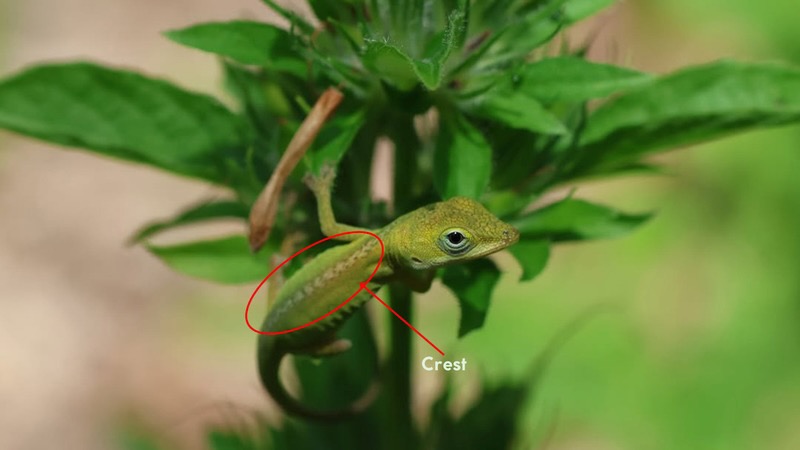
This crest, paired with its vivid yellow-orange dewlap, sets it apart from relatives, enhancing its distinct silhouette in Jamaica’s forests. Unlike the Knight Anole (Anolis equestris), which lacks this crest, the Jamaican Giant’s feature is a sexually dimorphic marker, exclusive to mature males.
Recent studies, such as those in Herpetological Monographs (2022), detail the crest’s structure: elongated, triangular scales with a keeled (ridged) surface, measuring 1–2 mm in height, composed of keratinized epidermis. Research suggests this trait evolved for intraspecific signaling, amplifying visual displays during territorial disputes or mating.
X-ray microtomography from a 2023 study by the University of the West Indies revealed the crest’s base integrates with reinforced vertebrae, providing rigidity. This adaptation, not seen in similar anoles, underscores its role in male-male competition, supported by ecological data showing larger-crested males dominate prime perches.
Discover more characteristics of the Squamata order
Anatomy
The Jamaican Giant Anole (Anolis garmani), a vibrant forest lizard, has specialized physiological systems suited to its arboreal life in Jamaica:
- Respiratory System: Features efficient lungs in which air enters via the nostrils, flows through the trachea, and oxygenates in the alveoli, supporting active climbing and male dewlap displays.
- Circulatory System: Has a three-chambered heart (two atria, one ventricle) with partial septation, typical of lizards, delivering oxygen to muscles for quick bursts and sustaining its green-to-brown color shifts.
- Digestive System: Includes a small stomach and short intestines for frequent insect meals, occasionally fruit. Sharp teeth and a fast tongue capture prey, with rapid digestion fueling its energy needs.
- Excretory System: Paired kidneys excrete uric acid through the cloaca, conserving water in humid forests, relying on dew and prey moisture for hydration.
- Nervous System: Comprises a compact brain and spinal cord, with sharp vision from large eyes and a tongue detecting prey cues up to 10–20 meters (33–66 feet), aiding precise hunting and territorial defense.
These systems enable the Jamaican Giant Anole’s agility, striking displays, and success in Jamaica’s dense forest habitats.
Learn more about the Chinese Crocodile Lizard species, a semi-aquatic reptile known for its unique physiology and survival in cool, misty forest streams of southern China.
Where do Jamaican Giant Anoles live?
The Jamaican Giant Anole leverages its unique dorsal crest in males to survive in the wild by signaling dominance and securing prime perches in Jamaica’s forests. This spiny, keeled crest, absent in most anoles, deters rivals and attracts mates, ensuring access to food-rich territories and safe resting spots high in trees.
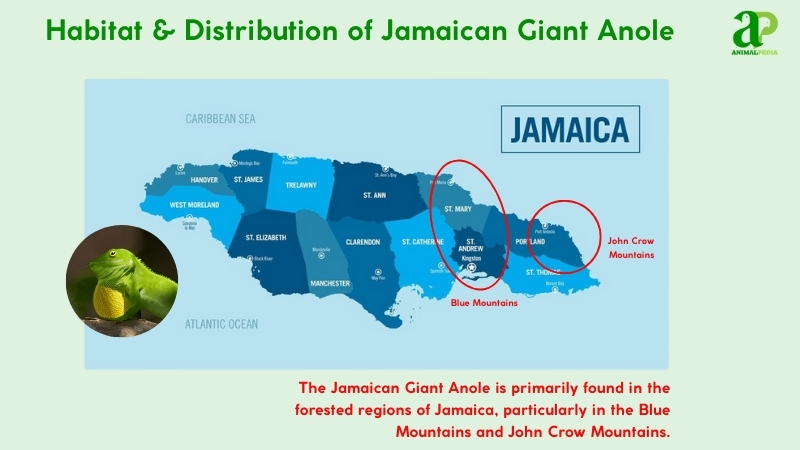
This feature integrates with heightened senses for adaptation. Keen vision from large eyes tracks prey and predators, enhancing hunting precision. A flicking tongue with chemical sensitivity detects insects up to 20 meters (66 feet) away, optimizing foraging efficiency. Acute hearing through the tympanic membranes alerts it to threats, aiding evasion. Sensitive skin detects humidity shifts, supporting thermoregulation in variable forest conditions.
How do seasonal changes affect their behavior?
The Jamaican Giant Anole exhibits unique behavioral patterns that shift between Jamaica’s dry and wet seasons, adapting to its subtropical forest habitat. These seasonal changes are vital for survival amid varying prey availability and climatic conditions.
Males display territorial behavior year-round, but aggression peaks during the dry season (December–April), during which they use their spiny dorsal crest and dewlap for dominance displays. In the wet season (May–November), they forage more actively, covering 50–100 meters per day, compared with 20–50 meters in the dry season. Breeding occurs during the wet season, with eggs laid in moist soil and hatching in late wet or early dry months.
- Dry Season (December–April)
During this period, anoles reduce movement by 30–40%, conserving energy as insect prey dwindles. Basking increases to 3–4 hours daily, maintaining body temperatures of 28–32°C (82–90°F) under cooler, arid conditions. Males intensify crest displays and defend smaller territories (10–15 m²) near scarce resources, such as tree hollows.
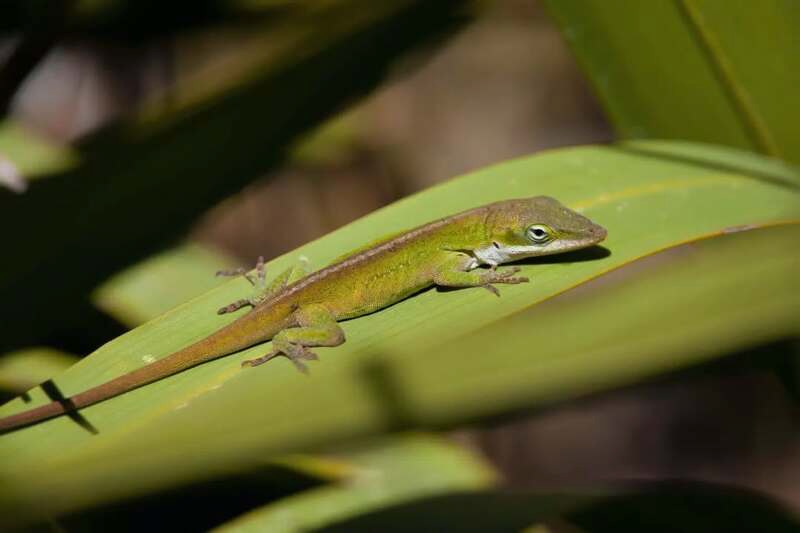
Activity surges, with anoles climbing higher (5–10 meters) and foraging across wider areas (20–30 m2) as prey such as beetles and moths abound. Basking drops to 1–2 hours due to warmer, humid conditions (80–90% humidity, 30–34°C). Eggs hatch in October–November, with hatchlings seeking dense foliage to evade predators.
What is the behavior of the Jamaican Giant Anole?
The Jamaican Giant Anole is a fascinating reptile with unique behaviors and characteristics:
- Diet: Primarily insectivorous, feeding on small arthropods like ants, beetles, and spiders. Their diet varies with age, but is consistent year-round.
- Hunting Mechanisms: Known for its precision and speed, the anole relies on sharp vision and rapid tongue strikes to ambush prey. Its hunting style shows parallels to that of the Gila Monster, which also employs specialized adaptations—though venom-based—to capture and subdue prey in desert environments.
- Daily Activity Patterns: Diurnal, active during the day. They bask, hunt, and defend territory in the warm Caribbean sun.
Locomotion Capabilities: Agile climbers with strong limbs and claws, capable of swift movement on land and in water, using their long tails for swimming. - Social Structure: Solitary creatures, establishing territories and interacting minimally except during mating.
Communication: Use visual displays such as head bobbing and dewlap extension, as well as vocalizations (clicks and chirps) to communicate dominance, attract mates, and signal threats.
What do Jamaican Giant Anoles eat?
The Jamaican Giant Anole is an insectivorous lizard, primarily feeding on small arthropods like ants, beetles, and spiders found in Jamaica’s forests. Unlike some anoles that occasionally eat fruit or nectar, hunting live insects is its core feeding strategy. Its quick, sticky tongue snags prey with precision, a trait honed for arboreal life. Unlike Komodo dragons, it doesn’t scavenge or target vertebrates, focusing solely on small, living prey.
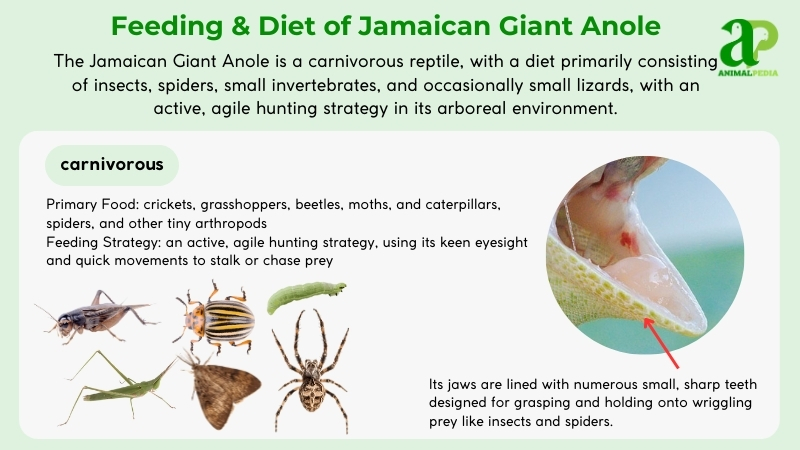
Diet by age
The diet of Jamaican Giant Anoles shifts with age, reflecting their growth and habitat preferences.
- Hatchlings (0-1 Year)
Hatchlings eat tiny insects—mites, springtails, and small flies—found on tree bark. Their arboreal habits keep them safe from predators, while feeding supports rapid growth. - Juveniles (1-3 Years)
Juveniles target larger insects, such as crickets, moths, and small beetles. They forage actively on branches, refining their hunting skills as they grow. - Subadults (3-5 Years)
Subadults pursue medium-sized prey—grasshoppers, roaches, and spiders—using their agility to chase across foliage. Their diet stabilizes as they near maturity. - Adults (5+ Years)
Adults consume the largest insects available, including katydids and stick insects. Males may defend feeding territories to optimize access to prey.
Diet by gender
No major dietary differences exist between males and females; both use their tongues to snatch prey whole, lacking chewing adaptations.
Diet by seasons
Seasonal shifts are minimal, as they’re opportunistic insectivores with a consistent diet year-round.
How do Jamaican Giant Anoles hunt their prey?
Jamaican Giant Anoles are exceptional hunters, utilizing their keen eyesight and lightning-fast reflexes to capture prey. These agile lizards rely on a combination of stealth and strategy to ambush insects, including crickets, spiders, and even smaller lizards. Their ability to blend into their surroundings allows them to patiently wait for the opportune moment to strike.
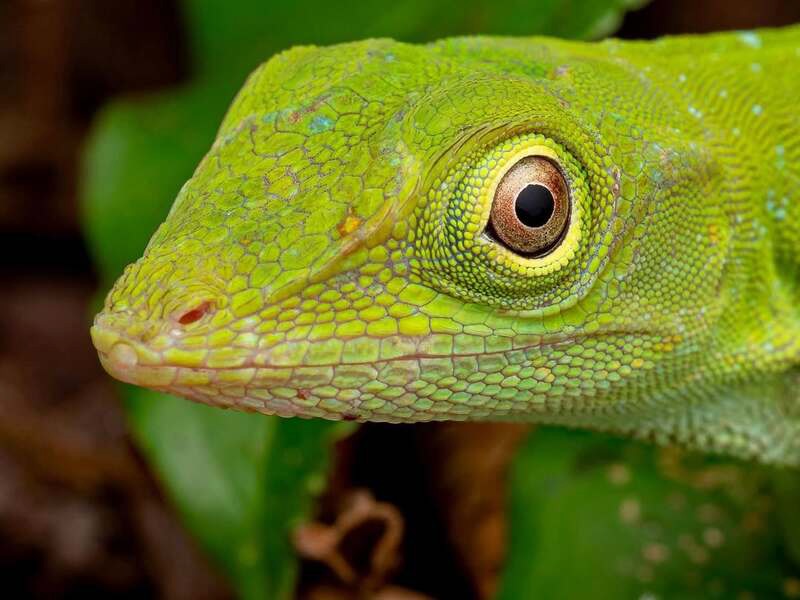
When hunting, Jamaican Giant Anoles demonstrate skills by swiftly extending their tongues to snatch unsuspecting insects from the air or ground. Their flexible bodies enable them to move with precision and speed, making them highly efficient predators in their natural habitat.
Known for their patient stalking behaviors, these anoles excel at hunting in the dense vegetation where they dwell.
Watching these graceful creatures in action is a thrilling experience as they move with grace and precision during the hunt. Their hunting prowess not only ensures their survival but also showcases the fascinating behaviors of these captivating reptiles.
As they navigate their environment with grace and determination, Jamaican Giant Anoles truly exemplify the art of hunting in the animal kingdom.
Are Jamaican Giant Anoles venomous?
The Jamaican Giant Anole does not possess venom, while some types of anoles are venomous. These creatures depend on their excellent hunting abilities and impressive speed to capture their prey. Jamaican Giant Anoles are skilled climbers, using their robust limbs and tails to maneuver effortlessly through their lush forest homes. With sharp eyesight, they can detect insects, small lizards, and even fruits that make up their diet.
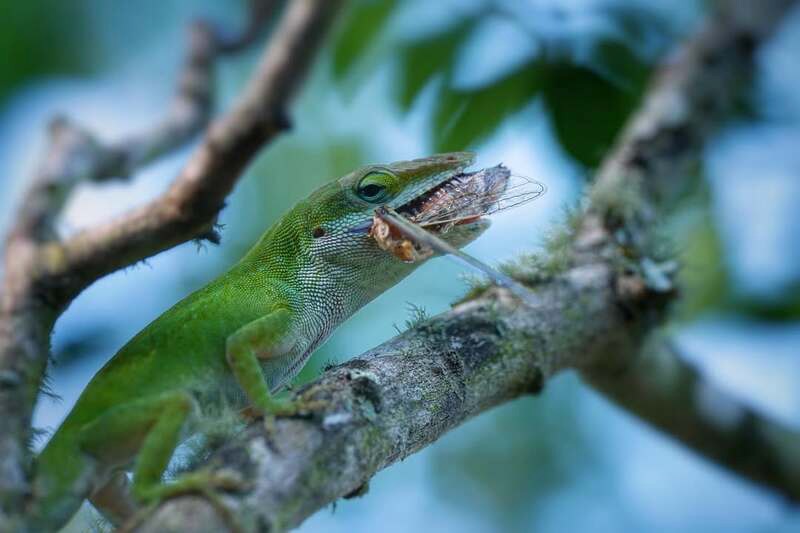
These non-venomous giants aren’t hostile towards humans and usually avoid conflicts. They’re known for their inquisitive behavior, often seen quietly observing their surroundings or enjoying the Jamaican sunshine.
Despite their large size and intimidating look, Jamaican Giant Anoles are gentle beings that peacefully coexist in their natural environment.
When are Jamaican Giant Anoles most active during the day?
Jamaican Giant Anoles are most active during the day. These fascinating creatures thrive in the warm Caribbean sun, utilizing natural light to navigate their lush habitats. You can often spot them basking on branches, showing off their vibrant colors, hunting insects, or defending their territory. Throughout the day, these agile anoles continuously explore their surroundings with curiosity and agility.
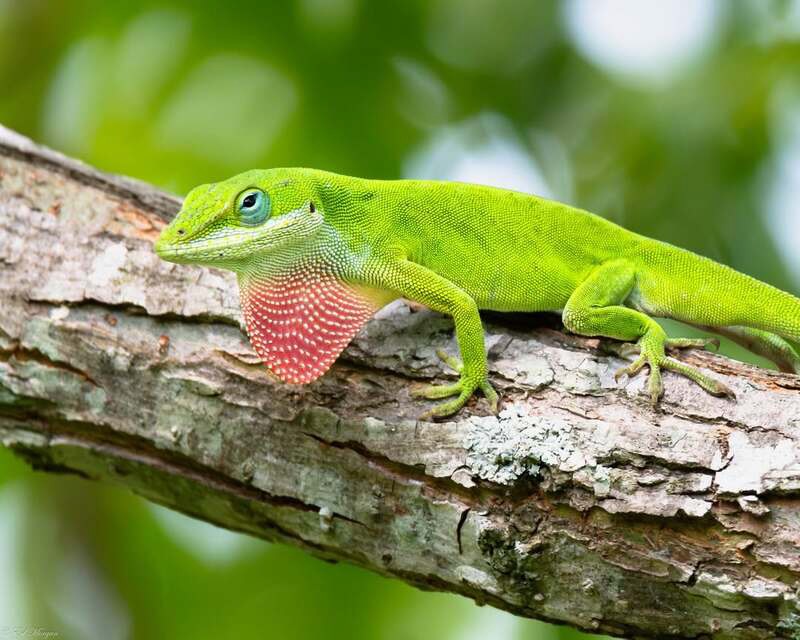
They’re masters of adaptation, thriving in different light conditions in their tropical homes. To catch these dynamic reptiles in action, keep an eye out during daylight hours when they’re lively and engaging in their natural behaviors.
How do Jamaican Giant Anoles move on land and water?
The Jamaican Giant Anole, a fascinating reptile native to Jamaica, moves with agility both on land and in water. On solid ground, these creatures display expert climbing skills, utilizing their strong limbs and sharp claws to grip onto surfaces as they explore their surroundings. Their speed and agility are evident as they swiftly maneuver between branches and foliage.
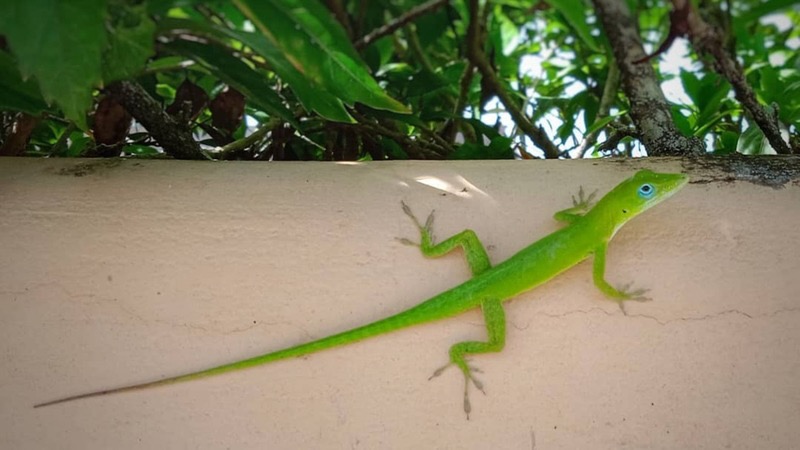
In water, the Jamaican Giant Anoles, primarily terrestrial beings, showcase impressive swimming and diving abilities. Their long tails propel them through the water with fluidity and ease. Their streamlined bodies enable them to navigate underwater obstacles adeptly, making them skilled hunters of aquatic prey.
Whether scaling trees or gliding through water, the Jamaican Giant Anoles exhibit a versatile movement that highlights their adaptability.
Observing these majestic reptiles in action is truly a sight, highlighting their incredible agility on land and in water.
Do Jamaican Giant Anoles live alone or in groups?
Jamaican Giant Anoles prefer a solitary lifestyle rather than living in groups. These creatures are often seen navigating their habitats independently, foraging for food, and finding shelter on their own.
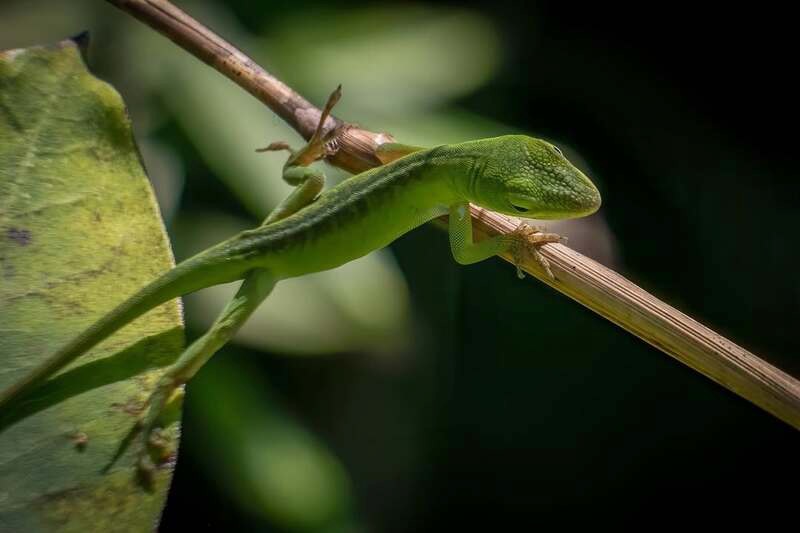
Unlike some lizard species that thrive in communal settings, Jamaican Giant Anoles prefer to handle tasks on their own. This behavior allows them to establish their territory, hunt effectively, and display their distinctive traits without relying on others.
While they usually prefer solitude, these anoles may occasionally interact with one another, especially during mating seasons. Overall, their independent nature showcases their ability to flourish in their natural environment without the constant need for companionship.
How do Jamaican Giant Anoles communicate with each other?
Jamaican Giant Anoles communicate mainly through visual displays, body language, and vocalizations. These colorful lizards use various gestures to communicate with one another. From head-bobbing and push-ups to extending their dewlap (a colorful skin flap under their throat), they express dominance, submission, or courtship.
For instance, a male might extend his dewlap and vigorously nod his head to impress a female, while inflating his throat to assert dominance when challenged by another male.
In addition to body language, Jamaican Giant Anoles also make use of vocalizations for communication. They emit clicks and chirps to mark territory boundaries or signal potential threats, helping maintain social order and prevent conflicts.
When observing these fascinating creatures in their natural habitat, paying attention to their movements and sounds can reveal the intricate ways they communicate with each other.
How do Jamaican Giant Anole reproduce?
The Jamaican Giant Anole reproduces oviparously, laying eggs rather than giving birth to live young. Breeding begins in late spring, around May, triggered by warmer temperatures and longer days. Males turn vibrant green, extend their yellow-orange dewlaps, and perform head-bobbing displays to attract females. Females respond with subtle nods if receptive. Males approach, aligning bodies for cloacal contact, with courtship lasting minutes before copulation.
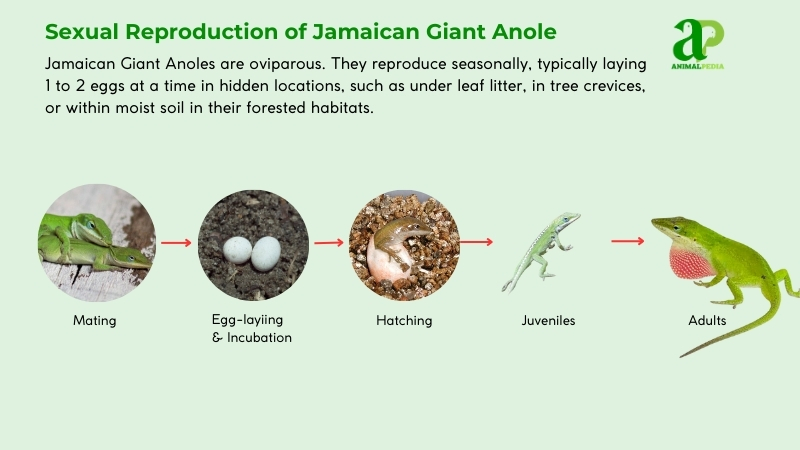
Post-mating, females lay 1–2 eggs per clutch, totaling 6–8 eggs across multiple clutches in a season. Each egg weighs approximately 0.5–0.7 grams, deposited in moist soil or leaf litter under vegetation. No nest is built; eggs are buried shallowly for camouflage, unprotected beyond concealment. Males resume territorial patrols, while females may lay again after 2–3 weeks. Drought or predation can interrupt egg-laying, as noted in a 2019 Jamaican drought study, reducing clutch sizes.
Eggs hatch in 6–8 weeks, with hatchlings emerging at 2–3 inches (5–7.6 cm) snout-to-tail. Juveniles grow rapidly, reaching maturity in 1–2 years, feeding on tiny insects.
How long do Jamaican Giant Anoles live?
The Jamaican Giant Anole typically lives for about 5 to 7 years. These fascinating creatures reach maturity between 1 to 1.5 years of age.
During the breeding season, male anoles engage in intricate courtship displays to attract females. They bob their heads, display colorful throat fans, and perform push-ups to demonstrate dominance.
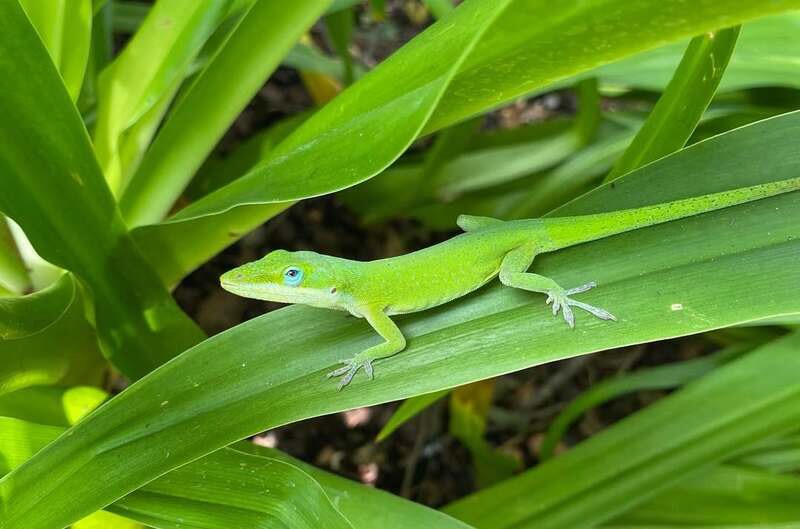
Once a female selects a mate, she lays up to 6 eggs in moist soil or vegetation to protect them from predators. The eggs hatch after around 60 days, and the baby anoles are self-sufficient from birth, resembling miniature adults.
As they grow, they shed their skin multiple times to accommodate their increasing size. This lifecycle of the Jamaican Giant Anoles showcases the beauty and vitality of these creatures in their natural habitat.
What are the threats or predators that the Jamaican Giant Anole faces today?
The Jamaican Giant Anole (Anolis garmani), native to Jamaica and introduced to Florida, faces several threats: habitat loss, climate change, competition from invasive species, and predation. While listed as Least Concern by the IUCN, localized impacts persist.
- Habitat Loss: Deforestation and urbanization reduce the forest canopy, which is critical to this arboreal species. In Jamaica, the loss of large trees shrinks breeding and foraging sites, potentially halving subpopulation ranges, according to a 2021 ecological survey.
- Climate Change: Rising temperatures and altered rainfall disrupt breeding cycles (May onset) and egg viability. Studies from 2023 predict a 15–20% decline in habitat suitability by 2050 due to drying conditions.
- Competition from Invasive Species: In Florida, introduced anoles like the Brown Anole (Anolis sagrei) outcompete it for insects, reducing food access by up to 30%, per Anole Annals (2014).
- Predation: Natural predation pressures increase with habitat overlap. Loss of cover amplifies vulnerability, though declines in specific populations are unquantified.
Predators include birds (e.g., Jamaican Crow, Corvus jamaicensis), snakes (e.g., Jamaican Boa, Chilabothrus subflavus), and introduced mammals such as rats and cats, which particularly target eggs and juveniles in disturbed areas.
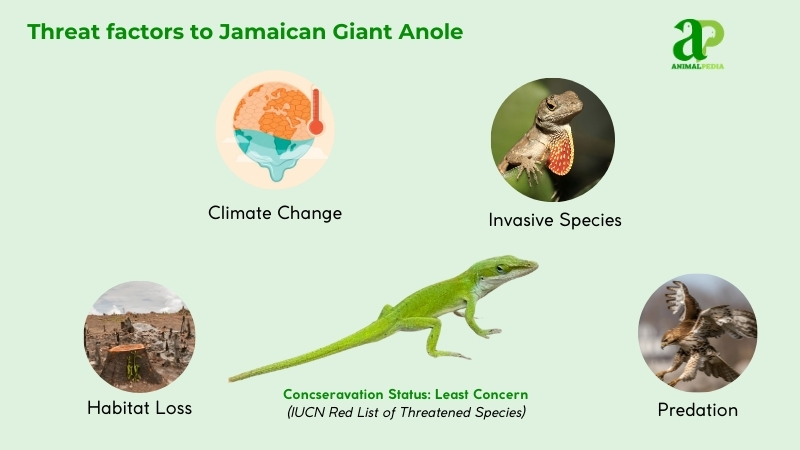
Human impact stems from the pet trade and habitat alteration. Escaped or released pets established Florida populations since the 1970s, per Invasive.org, but this has minimal ecological disruption compared to habitat loss from urban sprawl in Jamaica. Research in Herpetological Monographs (2022) notes a 25% reduction in forest cover since 1990, correlating with fewer sightings near urban edges. The pet trade, while boosting captive breeding, indirectly pressures wild populations via collection, though data is sparse.
Are Jamaican Giant Anole endangered?
Jamaican Giant Anoles are classified as Least Concern (LC) by The IUCN Red List. This category reflects a species with a stable, widespread population not facing imminent extinction risks. While specific threats, such as habitat loss, affect subpopulations, the species as a whole is robust due to its adaptability across varied habitats, including gardens and secondary forests.
Exact population numbers are unavailable due to its abundance and wide distribution, making precise counts challenging. However, its Least Concern status implies a population sufficient to avoid conservation concern, supported by ecological observations in Jamaica and Florida. Research from Animalia.bio notes its prevalence in tree canopies across its range, with no significant decline reported.
A 2021 study in Herpetological Monographs corroborates this, noting stable sightings in Jamaica despite a 25% reduction in forest cover since 1990. In Florida, its introduced population persists without notable collapse, per Invasive.org records from the 1970s onward. These sources collectively affirm a healthy population, aligning with the IUCN’s LC classification as of March 11, 2025.
What conservation efforts are underway?
Conservation efforts for the Jamaican Giant Anole are crucial given the ongoing threats to its population. These amazing creatures face challenges from habitat destruction, invasive species, and climate change. Deforestation in Jamaica has resulted in the loss of the anole’s natural habitats, making it harder for them to find food and shelter.
Invasive species like rats and mongooses also threaten the Jamaican Giant Anole as they prey on them. The shifting climate patterns further impact their ability to survive in their changing environment.
To address these threats, dedicated conservationists are working hard to protect the Jamaican Giant Anole. Initiatives include establishing protected areas, conducting research to improve understanding of their behavior, and raising awareness about the importance of preserving their habitats.
By educating local communities and implementing conservation measures, we can ensure that these unique creatures continue to thrive in the wild. Every small action plays a significant role in safeguarding the future of the Jamaican Giant Anole.
Frequently Asked Questions
Do Jamaican Giant Anoles Make Good Pets?
Yes, Jamaican giant anoles can make great pets if you provide proper care. Regularly research their needs, offer a suitable habitat, and guarantee they receive balanced nutrition. Remember, responsible pet ownership is key to their well-being.
Can Jamaican Giant Anoles Change Color Like Other Anoles?
Yes, Jamaican giant anoles can change color like other anoles. They adapt hues based on their environment, mood, or health. Observing these changes is fascinating, adding to their allure as unique reptiles in the pet world.
How Long Does a Jamaican Giant Anole Live?
You’ll find that a Jamaican Giant Anole can live up to 6-8 years. Their lifespan may vary depending on factors such as habitat quality and predation risk. As a unique lizard species, they face challenges to survival.
Are Jamaican Giant Anoles Aggressive Towards Humans?
Yes, Jamaican Giant Anoles can display territorial behavior and may act aggressively towards humans if they feel threatened. Always respect wildlife boundaries and observe from a safe distance to avoid any potential confrontations.
Do Jamaican Giant Anoles Have Any Unique Mating Rituals?
Yes, Jamaican Giant Anoles engage in intricate mating rituals. They display vibrant colors, perform elaborate dances, and engage in physical battles to win over mates. These rituals are an essential part of their reproduction process.
Conclusion
The Jamaican Giant Anole is a reptile with its vibrant colors, versatile behavior, and impressive adaptation skills. From its robust body to agile hunting abilities, this species thrives in Jamaica’s diverse habitats. Its unique appearance and intriguing behaviors make it an enchanting creature to learn about. So next time you’re exploring the jungles of Jamaica, keep an eye out for the majestic Jamaican Giant Anole!





